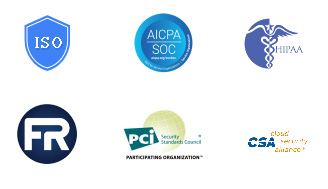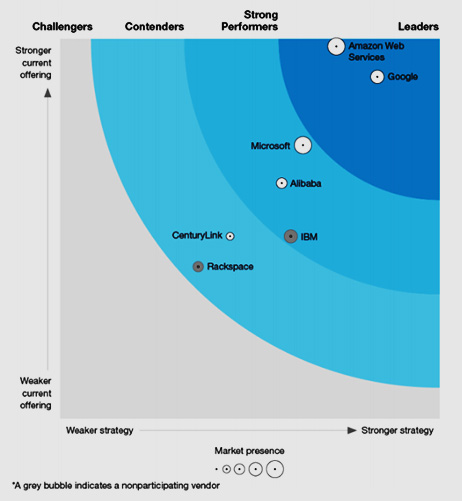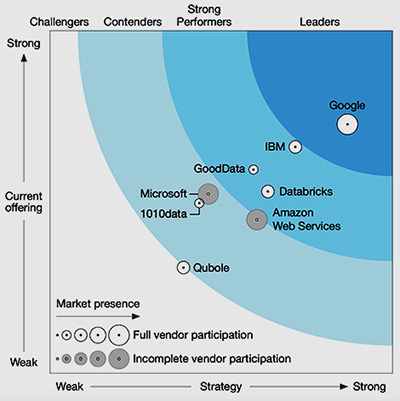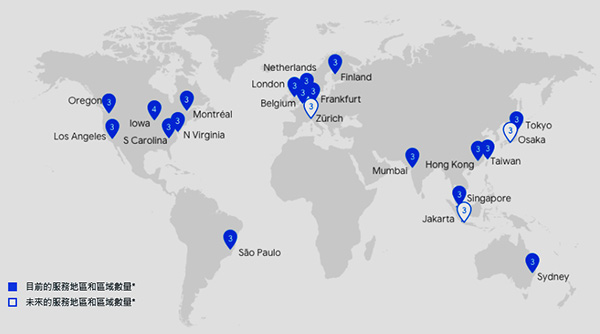(在家觀看 = 0%,在校觀看 = 100%)
100% 在校觀看日期及時間:
自由選擇,點選以下地區觀看辦公時間及位置
課時: 30 小時
享用時期: 10 星期。進度由您控制,可快可慢。
課堂錄影導師:Larry
在校免費試睇:首 3 小時,請致電以上地點與本中心職員預約。
本課程提供在校免費重睇及導師解答服務。
(在家觀看 = 100%,在校觀看 = 0%)
100% 在家觀看日期及時間:
每天 24 小時全天候不限次數地觀看
課時: 30 小時
享用時期: 10 星期。進度由您控制,可快可慢。
課堂錄影導師:Larry
在校免費試睇:首 3 小時,請致電以上地點與本中心職員預約。
本課程提供導師解答服務。
Google Cloud Platform (GCP) 的優勢
Google Cloud Platform 可以協助您解決任何難題,幫助您拓展事業。採用 Google Cloud Platform 之後,您不僅可以使用 Google Cloud Platform 的基礎架構和工具,也能透過 Google 的創新技術提供更優質的服務。
信任與安全性
Google Cloud Platform 提供安全性模型、世界級基礎架構以及獨有的創新技術,可協助您確保貴機構的安全性和法規遵循。為了協助您遵循法規及各項審計準則,Google 在此分享了一些資訊、最佳做法以及方便參考的說明文件。Google 的產品定期接受安全性、隱私權和法規遵循管理層面的獨立驗證審查,並取得全球標準認證 (例如 PCI DSS, HIPAA, ISO 27001, ISO 27017, ISO 27018 及德國聯邦資訊安全局 C5 等等),值得客戶信賴,而且Google也會持續確保旗下產品符合各項法規與標準。

Google Cloud Platform 的晶片、伺服器、軟體和私人網路均由 Google 自行設計與控管,因此您可以放心使用所有端對端服務。
Google Cloud Platform 會依預設為已儲存的靜態客戶資料 (Data at rest) 進行加密,因此您不需要採取任何動作。
在 The Forrester Wave 的 2018 年評選結果中,Google Cloud Platform 在「公用雲端平台原生安全性」項目獲得最高策略分數。

透過可靈活運用的開放原始碼技術拓展事業
您可能是採用混合式雲端、多雲端或內部部署的雲端技術。無論您目前或預計使用的是何種雲端服務,Google Cloud Platform 都能滿足您的需求並協助您拓展事業。
- 可穩定執行與管理的多雲端工具
- 可輕鬆遷移至 VM 或容器,價格選項極具彈性且無須綁約
- 盡可能依據社群需求推出的開放原始碼技術
透過 AI 與資料分析功能解決問題
Google Cloud Platform 可以協助您妥善運用手邊的資料,因為善用資料是Google的工作、強項與責任。只要能夠充分使用資料並發揮其價值,您就能解決先前無法解決的問題。
- 預先訓練好的自訂機器學習模型,可提升您的應用程式效能
- 可加快 TensorFlow 作業機器學習速度的 Cloud TPU
在 The Forrester Wave 的 2017 年評選結果中,Google Cloud Platform 在「PaaS 深入分析資料」項目獲得最高分數。

採用無伺服器 (ServerLess) 技術,提高開發人員生產力
無伺服器平台可讓您專注於編寫和部署程式碼,省去管理底層基礎架構的麻煩。這可讓開發人員專心打造出色的應用程式而不必煩惱其他瑣事,藉此提高開發人員的工作效率。零伺服器管理、無需預先佈建、自動調整資源配置以滿足流量需求、僅支付所使用的資源,這些都只是無伺服器運算的部份優點。從建立原型到大規模應用,您都不必擔心負載能力、穩定性或效能方面的問題。
- 無須預先佈建
- 省去伺服器管理作業
- 可持續整合及提供優質服務
使用 Google 的全球網路
您可以使用全世界最大的廣域私人雲端網路,並且享受低延遲、高回應速度的服務體驗。
- 超過 100 個服務據點
- 橫跨 18 個地區
- 10 萬英里的光纖纜線
Google Cloud Platform 服務地區已拓展至香港,目前服務規模已達 18 個地區、55 個區域,共在 35 個國家 / 地區累計超過 100 個服務據點,且具備完善的全球網路,擁有超過 10 萬英里的光纖纜線。

| 課程時數: | 30 小時 (共 10 堂,共 1 科) |
| 適合人士: | 有志考取 Google Cloud Platform Associate Cloud Engineer 證書人士 或 有志投身 I.T. 界的人士 |
| 授課語言: | 以廣東話為主,輔以英語 |
| 課程筆記: | 本中心導師親自編寫英文為主筆記,而部份英文字附有中文對照。 |
| 1. 模擬考試題目: | 本中心為學員提供模擬考試題目,每條考試題目均附有標準答案。 |
| 2. 時數適中: | 本中心的 Google Cloud Platform Associate Cloud Engineer (GCP-ACE) 國際認可證書課程時數適中,有 30 小時。 令學員能真正了解及掌握課程內容,而又能於 2 個月內考獲以下 1 張國際認可證書:
|
| 3. 導師親自編寫筆記: | 由本中心有教授各種各樣雲端相關課程 (包括Google Cloud, Amazon AWS, Microsoft Azure, Alibaba Cloud, Tencent Cloud, Rackspace, OpenStack等等) 的資深導師 Larry Chan 親自編寫筆記,絕對適合考試及實際管理之用,令你無須「死鋤」如字典般厚及不適合香港讀書格調的書本。 |
| 4. 一人一機上課: | 本課程以一人一機模式上課。 |
| 5. 免費重讀: | 傳統課堂學員可於課程結束後三個月內免費重看課堂錄影。 |
Google 已公佈考生只要通過以下 1 個 Google Cloud Platform 相關科目的考試,便可獲發 Associate Cloud Engineer 國際認可證書:
|
本中心為 Kryterion 指定的 Google Cloud Platform 考試試場,考生可在本中心應考。考生須自行繳付USD125 之考試費。 |
|
課程名稱:Google Cloud Platform Associate Cloud Engineer (GCP-ACE) 國際認可證書課程 - 簡稱:Google Cloud Training Course (GCP-ACE) |
GCP-ACE (30 hrs)
1. Introduction to Google Cloud Platform
1.1 What is Cloud Computing
1.2 Trends in Google Cloud
1.3 Google Cloud Platform Infrastructure
1.4 GCP Regions and Zones
1.4.1 Zonal Resources
1.4.2 Regional resources
1.4.3 Multi-regional resources
1.5 GCP’s Environmental Responsibility
1.6 Customer-Friendly Pricing
1.6.1 Per-Second Billing
1.6.2 Sustained-use discounts
1.6.3 Custom Virtual Machine types
1.6.4 Extended custom memory
1.7 Open Source
1.8 Security in GCP
1.9 Major Services provided by GCP
1.9.1 Compute services
1.9.2 Storage Services
1.9.3 Big Data services
1.9.4 Machine Learning services
2. Getting Started with Google Cloud Platform
2.1 Tasks and Responsibility of different cloud models
2.2 GCP Resource Hierarchy
2.3 Arranging GCP Resources with Projects
2.4 Folders for Flexible Management
2.5 Organization node
2.6 An Example of IAM Resource Hierarchy
2.7 Google Cloud IAM
2.7.1 The “Who” part
2.7.2 That “can do what” part
2.7.3 The “on which resource” part
2.7.4 Three types of IAM Roles
2.7.5 Service Accounts in GCP
2.8 Google Cloud Identity
2.9 Four ways to interact with Google Cloud Platform
2.9.1 Google Cloud Platform Console
2.9.2 Google Cloud Shell
2.9.3 Google Cloud SDK
2.9.4 RESTful APIs
2.9.5 Using Client Libraries to control GCP resources from within your own code
2.9.6 Cloud Console Mobile App
2.10 Cloud Marketplace
3. Virtual Machines and Networks in the Cloud
3.1 VPC Networking
3.2 Compute Engine Virtual Machines
3.3 Compute Engine Friendly Pricing
3.4 Scale up or Scale out with Compute Engine
3.4.1 Changing the Machine Type of a Stopped instance
3.4.2 Using and Applying Size Recommendation
3.4.3 Installing and Authorizing StackDriver Monitoring Agent
3.5 Routing in Google Cloud Platform VPC
3.5.1 VPC Route table in Auto Mode
3.5.2 About Subnet Routes
3.5.3 Custom routes
3.6 Firewall Rules in Google Cloud Platform VPC
3.6.1 Traffic types which are Always Blocked in GCP
3.6.2 Traffic types which are Always Allowed in GCP
3.6.3 Firewall Rule Components
3.6.4 About Firewall Rule Priority
3.6.5 About Direction of Traffic
3.6.6 About Targets of Firewall Rules
3.6.7 Targeting with Service Account vs. Targeting with Network Tag
3.6.8 Ingress firewall rule example use case
3.6.9 Egress firewall rule example use case
3.6.10 More about Google’s QUIC Protocol
3.7 VPC Network Peering
3.7.1 Use cases
3.7.2 General Network Pricing
3.7.3 Internet Egress Rates
3.7.4 Setting up the Environment for VPC Network Peering
3.7.5 Configure VPC Network Peering
3.8 VPC In-depth networking knowledges
3.8.1 Responsibility of different actions of Compute Engine virtual maches
3.9 Private Google Access
3.9.1 Enabling API
3.9.2 Adding and Configuring a Subnet with Private Google Access
3.10 GCP Load Balancing Types
3.10.1 Global versus regional load balancing
3.10.2 Global Load Balancing
3.10.3 Creating Instance Groups
3.10.4 Creating a Cross Region Global Load Balancer for HTTP
3.10.5 Creating a Cross Region SSL/TLS Load Balancer
3.10.6 SSL Proxy Load Balancing
3.11 Cloud DNS
3.11.1 To create a Managed Private zone
3.11.2 VPC Name resolution order
3.11.3 DNS Server policy
3.12 Cloud VPN
3.12.1 Creating a Route-Based VPN connection
4. Storage in the Cloud
4.1 Introduction to GCP Cloud Storage
4.2 Cloud Storage Bucket
4.3 Bucket-Only Policy and Access Control
4.4 Cloud Storage Object Lifecycle
4.4.1 Introduction to Object Lifecycle Management
4.4.2 Create and Enable Object lifecycle management rule
4.4.3 Cloud Storage Retention Policy
4.4.4 Cloud Storage Audit Logging
4.5 Cloud SQL
4.5.1 Introduction to Cloud SQL
4.5.2 Creating a Second-Generation SQL instance
4.5.3 TLS connection to MySQL instance
4.5.4 Connect to Cloud SQL using Private IP
4.5.5 Cloud SQL High Availability
4.5.6 About Replication Lag
4.5.7 Cloud SQL Backup and Restore
4.5.8 Performing Point-In-Time recovery of Cloud SQL instance
4.6 Other Storages in the GCP Cloud
4.6.1 Cloud Bigtable
4.6.2 Cloud Spanner
4.6.3 Cloud Datastore/Firestore
4.7 A Comparison of GCP Cloud Storage technologies
5. Containers in the Cloud
5.1 Brief Introduction to Containers
5.2 Introduction to Kubernetes (K8S)
5.3 Creating and Deploying Containerized Application
5.3.1 Build the container image
5.3.2 Upload the container image
5.3.3 Run your container locally
5.3.4 Create a container cluster
5.3.5 Deploy your application
5.3.6 Expose your application to the Internet
5.3.7 Scale up your application
5.3.8 Deploy a new version of your app
5.3.9 Cleaning up
5.4 Using Persistent Disk with GKE
5.4.1 Create a GKE cluster
5.4.2 Create your PersistentVolumes and PersistentVolumeClaims
5.4.3 Set up MySQL
5.4.4 Set up WordPress
5.4.5 Visit your new WordPress blog
5.4.6 Test data persistence on failure
5.4.7 Updating application images
5.4.8 Cleaning up
6. Serverless Applications in the Cloud
6.1 Introduction to GCP App Engine
6.2 App Engine Standard Environment
6.3 App Engine Flexible Environment
6.4 Traffic Splitting in App Engine Environment
 付款。
付款。